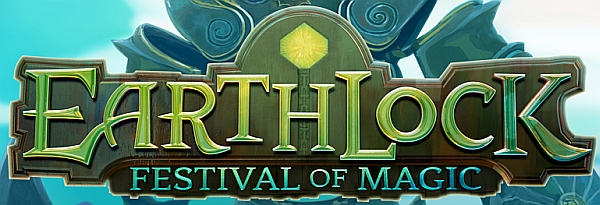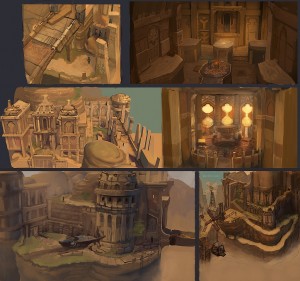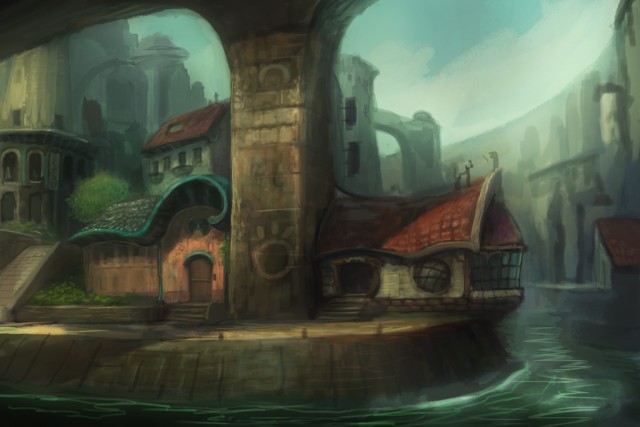
Earthlock: Festival of Magic was one of those rare Kickstarter projects that immediately grabbed our attention with its strong, colourful art direction, firm sense of genre, and polished gameplay. Its ambition was only matched by the passion of small Norwegian outfit Snowcastle Games, who, with only a couple of games under its belt, sought $150,000 to make a huge RPG for both PC gamers as well as the new generation of consoles. Originally featured in March 2014’s Guinness Aftermath Edition of Kickstart This!, Earthlock: Festival of Magic is expected to be released for the PC, PS4, Wii U, and Xbox One later this year.
We caught up with Bendik Stang, Snowcastle’s Game Director, earlier this year to talk about the team’s progress from campaign to nearly-finished product, as well as their experience at the 2015 Game Developers Conference. He even shared two brand new pieces of concept art with us…
Andrew Rainnie, Warp Zoned UK Correspondent: Earthlock: Festival of Magic was featured in our Kickstart This! column in March 2014. Did you design the project with Kickstarter in mind, or did you pursue other funding avenues before crowdfunding became viable?
Bendik Stang, Game Director at Snowcastle Games: We surely did not think of Kickstarter when we began this project. Even just seven months before we ran the Kickstarter, we did not think we would stand a chance if we tried. But then we got such great feedback on our Steam Greenlight process. That made us dare to take the leap and go for a Kickstarter campaign. That, and the fact that we were getting pretty low on funds.
As for funding, I think we have tried almost everything: friends and family, personal inheritance, professional investors, contract work, venture capital, and finally Kickstarter. We never got anything from the venture capitalists though.
 WZ – Andrew: The Kickstarter campaign had a substantial goal of $150,000. How did you come up with that number? At any point did you worry that it was perhaps too big?
WZ – Andrew: The Kickstarter campaign had a substantial goal of $150,000. How did you come up with that number? At any point did you worry that it was perhaps too big?
Stang: $150,000 was the minimum we needed to meet the requirements for a production grant from the Norwegian Film Institute. We wanted to ask for more, but we could also see that for an unknown indie developer such as us it was highly unlikely that we could manage to raise more. At the time, it was beginning to get a lot harder raising more than $100,000 so we were already pushing it.
The Kickstarter was a success so we also got the grant worth $145,000. It got us through the hardest part of the financing.
WZ – Andrew: Sticking with the campaign target, you set a stretch goal of $180,000 to get a fully orchestral score, and you narrowly missed it, finishing on $178,193. Was it something you wished you had achieved?
Stang: Well, we continued the campaign on our website with PayPal, and I can inform you that we did in fact pass $180,000 so we will be doing the full orchestral score. Our composer, Eiko Ishiwata, is such a wonderful musician and I think it is super cool that she will get all her music recorded by a full orchestra. It’s going to sound better too.
WZ – Andrew: Five other games were included in the same column as Earthlock: Festival of Magic, and amazingly, all six managed to achieve their funding goal. That’s the one and only time in the three year history of Kickstart This! that’s happened What do you think about that?
Stang: You should consider starting your own game fund or change your business to publishing! That or you were extremely lucky in your selection.
WZ – Andrew: Snowcastle has made a couple of iOS games, Hogworld and Scale Tower. What was it like going from those small-scale projects to a massive RPG for the PC and home consoles?
Stang: Mind blowing, scary, and super fun. It’s incredibly hard to raise the needed funds to create such an ambitious project as Earthlock. It’s also hard to find and hire the talented people we need to make the game really great. Against all odds, it seems like we are almost there now. Over the last 12 months we have hired some fantastically talented developers with tons of experience from Ubisoft, Rockstar, and Frontier. We have managed to raise the last part of the funds needed to complete the game too. I have never been more happy about the way things are going at Snowcastle.
WZ – Andrew: Initially it was just yourself and Erik Hoftun that founded and ran the company in 2009, but with this project you have taken on a number of additional developers and creatives. Were these people that you knew, or did you advertise for the roles?
Stang: We had our Art Director Frits Olsen from the start. He is one of the most talented artists I have met and I noticed his talent for the first time when he was only 16 years old. When we started Snowcastle, Frits had just completed his Masters in Illustration and Character Design. I was super happy I managed to get him on board before someone else snatched him.
Most of the developers we had from before the Kickstarter campaign are people we have found through our local network. After Kickstarter we have used websites like Gamasutra for job openings. Since the original team did not have any prior experience making games it has been vital to get some really experienced people on board. We now have senior developers with over 10 years experience from some of the hottest studios in the world. Getting that kind of experience on board helps level up all the other developers as well.
WZ – Andrew: You have visited the Game Developers Conference several times, rubbing shoulders with famous game developers. What is it like coming to these big events to show off a game you achieved through crowdfunding?
Stang: I think the indie scene is a place with really down-to-earth and friendly people. All of the famous developers I have met have been really welcoming. One of my favourite games when I was a kid was the Quest For Glory series from Sierra. Then Lori Anne Cole and Corey Cole backed Earthlock and helped spread the word. How cools is that? Also, I decided to become a game developer while playing Ultima Online in 1999 so you can imagine how thrilled I was then Richard Garriott backed and tweeted about Earthlock. I think it is also worth mentioning that I have contacted many indie developers and asked for advice. Never once have we been turned down. I think the information sharing mentality is unique for our industry.
WZ – Andrew: What is the game development scene like in your native Norway?
Stang: It’s really small. It’s like a little greenhouse with lots of small but beautiful sprouts. It seems like all the Norwegian developers I know genuinely want to help the others succeed. I think it makes a big difference and we all gain from it.
A lot of good stuff is happening here and I believe it’s just a matter of time before you will see a many cool games coming out of Norway. After all, the country needs some other income after the oil runs out.
WZ – Andrew: Back to the Kickstarter campaign. The game was advertised as coming to the new-gen consoles, including the Wii U. Is that still the case? When can we expect it to launch?
Stang: We are approaching beta, and are targeting submission for certification in the late fall. Since we have never gone through a console certification process, we don’t quite know how long it will take, but we are trying to get it done before the year runs out. Launch will then follow, but we will take our time to find a good launch window. We only get one chance to launch, so we will carefully choose the best window for this.
WZ – Andrew: In my initial feature, I described the game as being “like Xenoblade Chronicles with a strong dash of Disney and a side salad of Studio Ghibli.” What sources of inspiration did you draw from to create the epic world of Earthlock?
Stang: Oh, you were so spot on! I don’t think it is much more to say about that. Well, maybe a dash of inspiration from the Final Fantasy series as well.
WZ – Andrew: How important was the Kickstarter community to you? How did you go about spreading word about the game?
Stang: Given that game development requires really focused creative skills like programming, drawing, design, sound, etc. It is fascinating that it is possible to uproot all the people with those skills and force them to work as PR people 24/7 for a month! We surely all were outside our comfort zone, but we put aside introvert personality and shyness and reached out to anyone that would listen.
We ended up with almost 5,000 backers. That is a lot of people when you think about it. I have tried to imagine all of them in a room in front of me. The thought is quite scary, but what a morale boost! I am sure we would have folded had the campaign failed. When the game is out, any of our backers can proudly say that they helped make this game. It is completely true!
WZ – Andrew: Kickstarter and other crowdfunding sites have changed the face of gaming forever. Do you think it will continue to be a creative hub for gamers and game developers, challenging standard conventions, or do you think it will diminish as the years go by?
Stang: I think and hope it is here to say. It is a completely disruptive way of funding games, and anything else for that matter. I really love what it exists! That said, I sincerely hope I will never have to run another Kickstarter campaign. It is by far the hardest and most taxing thing I have ever done.
I am also worried that developers are underbidding themselves down to a point where the money you get from Kickstarter is almost less than it cost to run the campaign. Making games is really expensive, and I have a feeling many backers severely underestimates what it costs to run a company.
Indies considering a crowdfunding campaign are faced with a Catch-22. If you ask for what you need, there is no way you will succeed with the campaign. If you ask for what you think you can get, you won’t have quite enough to complete the game. You also want to be honest with your backers. It’s a difficult balance, but it is possible. I think the best example I have seen is how Cory Cole has been completely transparent. But then again, they had a big fan base and could ask for a reasonable amount of money. Small, unknown indies are not so fortunate.
WZ – Andrew: I know you are still beavering away at Earthlock: Festival of Magic, but once it has been completed, what is next for Snowcastle? Even if you do not have a specific game in mind (or cannot share), is there a specific genre that you would like to tackle?
Stang: When we are done with Earthlock: Festival of Magic, we are only a third of the way to our goal. Next up is Earthlock: The Final Memory, and after that, Earthlock: The Awakening!
We are ambitious. We are not just trying to make a game, we are trying to make an IP out of the Earthlock universe. I think it is such a cool universe and we only get to show a little part of it in the first game. I have gotten some flak for being overly ambitious from time to time, however this recent post on Kotaku about the industry’s need for sequels gave me some confidence that we are on the right track.
WZ – Andrew: What games do you play as a gamer? Do the developers at Snowcastle play as a team online, or do you all do your own thing?
Stang: Apart from a Mario Kart 8 race during our lunch break from time to time, we tend to do our own thing. Since we all like the genre we are making, it seems natural that we also tend to play single-player, story-driven games, with elements of tactical gameplay. From what the other developers are talking about, it seems like this is exactly what they are playing.
WZ – Andrew: Do you have any advice to give to prospective game developers seeking crowdfunding contributions?
Stang: Do your homework. You need to be really prepared to succeed. You also need to know that you have enough people that will back you to get at least 30% or so. If nobody knows about your project, please don’t do a Kickstarter. Wait, build a fan base first.
WZ – Andrew: Our thanks to Bendik and all the team at Snowcastle, and we wish them all the best with Earthlock: Festival of Magic.








